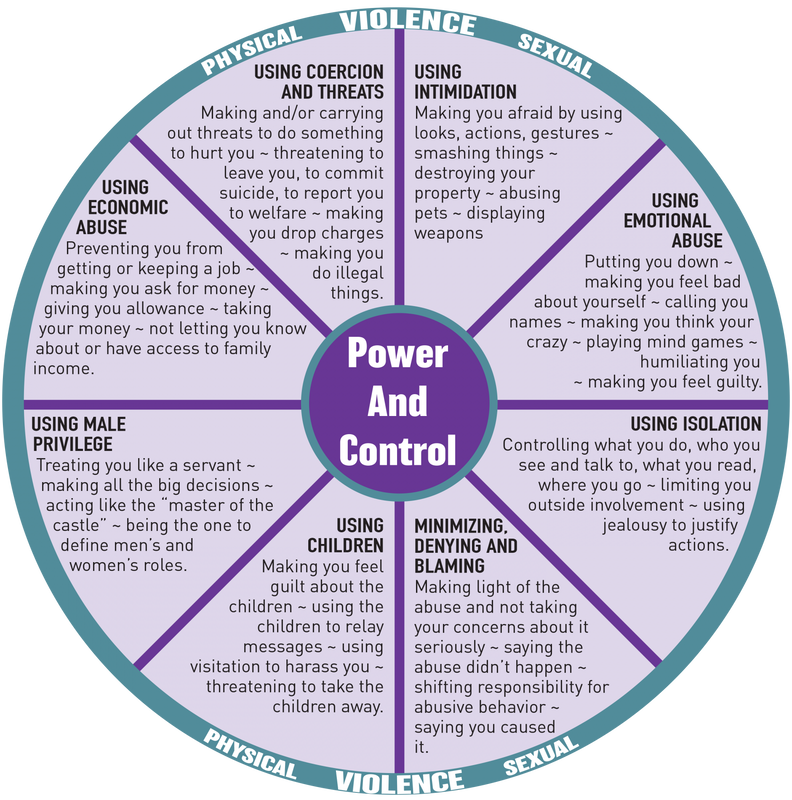Lesson 10: Abuse
Abuse is any behavior that results in the mistreatment of another person. Abuse can take on many different forms including physical, emotional (verbal), mental, sexual, social, and spiritual abuse. When a person finds himself or herself the victim of abuse, it is important that her or she examine his or her role in the abuse cycle. Those who remain in abusive situations often times play the role of "enabler" by enabling the abuser's behavior. Enabling behavior is just as dysfunctional as the abuse itself and is usually the result of such things as:
Signs of an Abusive Relationship
Do You:
Does Your Partner:
Abuse is about power and control (see Illustration 1 below).
- Failure to enforce boundaries
- Failure to establish consequences for abusive behavior
- Low self-esteem
- Fear
- Ignorance, lack of know-how
- Not having an action plan
- Not having adequate support or resources
- A false hope that things will be better "the next time"
Signs of an Abusive Relationship
Do You:
- Feel afraid of your partner much of the time?
- Avoid certain topics out of fear of angering your partner?
- Feel that you can't do anything right for your partner?
- Believe that you deserve to be hurt or mistreated?
- Wonder if you're the one who is crazy?
- Feel emotionally numb or helpless?
Does Your Partner:
- Humiliate, criticize, or yell at you?
- Treat you so badly that you're embarrassed for your friends or family to see?
- Ignore or put down your opinions or accomplishments?
- Blame you for his or her own abusive behavior?
- See you as a sex object, rather than as a person?
Abuse is about power and control (see Illustration 1 below).
Illustration 1 - Power and Control Abuse Wheel
If you discover that your client is a victim of abuse, the first consideration needs to be your client's safety. If your client is in a life threatening or unsafe situation, then you will first want to establish a "safety plan" with him or her before engaging in any further self-healing work. This may mean encouraging your client to relocate somewhere away from his or her abuser, and in some cases, it may also mean getting a restraining order. Once your client is safe you can begin the counseling process and help him or her work through any areas of challenge he or she may have as listed above.
Break the Cycle of Abuse
Abuse plays itself out in cycles. In order to end the abuse cycle, your client will need to engage in the cycle of personal responsibility (see Illustration 2 below). Once your client is ready to break the abuse cycle in his or her life, you can work with him or her to create a plan of action and hold him or her accountable for moving forward with that plan.
Break the Cycle of Abuse
Abuse plays itself out in cycles. In order to end the abuse cycle, your client will need to engage in the cycle of personal responsibility (see Illustration 2 below). Once your client is ready to break the abuse cycle in his or her life, you can work with him or her to create a plan of action and hold him or her accountable for moving forward with that plan.
Illustration 2 - Cycle of Abuse and Cycle of Personal Responsibility
Podcast Episode
Often times in abusive relationships, an abuser will use a manipulation tactic referred to as gaslighting to get the other person to second guess his or her own reality. This is something you should be aware of and know what to do if you discover your client is being gaslighted by his or her abuser. Take a listen to the podcast episode below to learn more:
Assignment
- Read It's Not Okay Anymore, Your Personal Guide to Ending Abuse, by Greg Enns and Jan Black.


